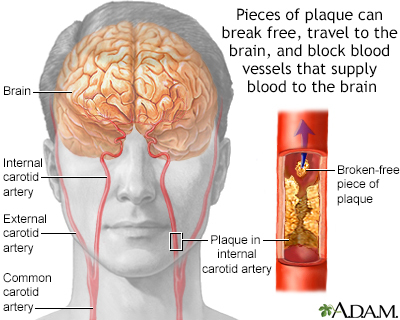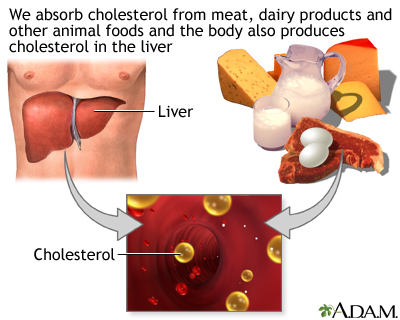Angioplasty and Stent Placement - Carotid Artery
Definition
The blood vessels that bring blood to your brain and face are called the carotid arteries. You have a carotid artery on each side of your neck.
The blood flow in this artery can become partly or totally blocked by fatty material called plaque. A partial blockage is called carotid artery stenosis (narrowing). A blockage in your carotid artery can reduce the blood supply to your brain. Sometimes part of a plaque can break off and block off another artery. A stroke can occur if your brain does not get enough blood.
Two procedures can be used to treat a carotid artery that is narrowed or blocked. These are:
- Surgery to remove plaque buildup (endarterectomy)
- Carotid angioplasty with stent placement

Alternative Names
Carotid angioplasty and stenting; CAS; Angioplasty - carotid artery; Carotid artery stenosis - angioplasty
Description
Carotid angioplasty and stenting (CAS) is done using a small surgical cut.
- Your surgeon will make a surgical cut in your groin after using some numbing medicine. You will also be given medicine to relax you.
- The surgeon places a catheter (a flexible tube) through the cut into an artery. It is carefully moved up to your neck to the blockage in your carotid artery. Moving x-ray pictures (fluoroscopy) are used to see the artery and guide the catheter to the correct position.
- Next, the surgeon will move a wire through the catheter to the blockage. Another catheter with a very small balloon on the end will be pushed over this wire and into the blockage. Then the balloon is inflated.
- The balloon presses against the inside wall of your artery. This opens the artery and allows more blood to flow to your brain. A stent (a wire mesh tube) may also be placed in the blocked area. The stent is inserted at the same time as the balloon catheter. It expands with the balloon. The stent is left in place to help keep the artery open.
- The surgeon then removes the balloon.
Patient Education Video: Stent
Why the Procedure Is Performed
Carotid surgery (endarterectomy) is an older and effective way to treat narrowed or blocked arteries. This procedure is very safe.
CAS has developed as a good alternative to surgery in some cases, when done by experienced operators. Certain factors may favor stenting, such as:
- The person is too ill to have carotid endarterectomy.
- The location of the narrowing in the carotid artery makes surgery harder.
- The person has had neck or carotid surgery in the past.
- The person has had radiation to the neck.
Risks
Risks of carotid angioplasty and stent placement, which depend on factors such as age, are:
- Allergic reaction to dye
- Blood clots or bleeding at the site of surgery
- Brain damage
- Clogging of the inside of the stent (in-stent restenosis)
- Heart attack
- Kidney failure (higher risk in people who already have kidney problems)
- More blockage of the carotid artery over time
- Seizures (this is rare)
- Stroke
Before the Procedure
Your health care provider will do a physical exam and perform several medical tests.
Always tell your provider what medicines you are taking, including drugs, supplements, or herbs you bought without a prescription.
During the 2 weeks before your procedure:
- Days before the surgery, you may have to stop taking medicines that make it harder for your blood to clot. These include aspirin, ibuprofen (Advil, Motrin), clopidogrel (Plavix), ticagrelor (Brilinta), prasugrel (Effient), naprosyn (Aleve, Naproxen), and other medicines like these.
- Ask your provider which medicines you should still take on the day of your surgery.
- If you smoke, you need to stop. Ask your provider for help quitting.
- Always let your provider know about any cold, flu, fever, herpes breakout, or other illness you may have before your surgery.
DO NOT drink anything after midnight the night before your surgery, including water.
On the day of your surgery:
- Take the medicines you have been told to take with a small sip of water.
- You will be told when to arrive at the hospital.
After the Procedure
After surgery, you may need to stay in the hospital overnight so that you can be watched for any signs of bleeding, stroke, or poor blood flow to your brain. You may be able to go home the same day if your procedure is done early in the day and you are doing well. Your provider will talk to you about how to care for yourself at home.
Outlook (Prognosis)
Carotid artery angioplasty and stenting may help lower your chance of having a stroke. But you will need to make lifestyle changes to help prevent plaque buildup, blood clots, and other problems in your carotid arteries over time. You may need to change your diet and start an exercise program if your provider tells you exercise is safe for you. Your doctor may prescribe medicines for you to take also.

Gallery



References
Aboyans V, Ricco JB, Bartelink MEL, et al. Editor's choice - 2017 ESC guidelines on the diagnosis and treatment of peripheral arterial diseases, in collaboration with the European Society for Vascular Surgery (ESVS). Eur J Vasc Endovasc Surg. 2018;55(3):305-368. PMID: 28851596 pubmed.ncbi.nlm.nih.gov/28851596/.
Brott TG, Halperin JL, Abbara S, et al. 2011 ASA/ACCF/AHA/AANN/AANS/ACR/ASNR/CNS/SAIP/SCAI/SIR/SNIS/SVM/SVS guideline on the management of patients with extracranial carotid and vertebral artery disease: executive summary: a report of the American College of Cardiology Foundation/American Heart Association Task Force on Practice Guidelines, and the American Stroke Association, American Association of Neuroscience Nurses, American Association of Neurological Surgeons, American College of Radiology, American Society of Neuroradiology, Congress of Neurological Surgeons, Society of Atherosclerosis Imaging and Prevention, Society for Cardiovascular Angiography and Interventions, Society of Interventional Radiology, Society of NeuroInterventional Surgery, Society for Vascular Medicine, and Society for Vascular Surgery. Developed in collaboration with the American Academy of Neurology and Society of Cardiovascular Computed Tomography. Catheter Cardiovasc Interv. 2013;81(1):E76-E123. PMID: 23281092 pubmed.ncbi.nlm.nih.gov/23281092/.
Brott TG, Howard G, Roubin GS, et al. Long-term results of stenting versus endarterectomy for carotid-artery stenosis. N Engl J Med. 2016;374(11):1021-1031. PMID: 26890472 pubmed.ncbi.nlm.nih.gov/26890472/.
Hicks CW, Malas MB. Cerebrovascular disease: carotid artery stenting. In: Sidawy AN, Perler BA, eds. Rutherford's Vascular Surgery and Endovascular Therapy. 9th ed. Philadelphia, PA: Elsevier; 2019:chap 92.
Kinlay S, Bhatt DL. Treatment of noncoronary obstructive vascular disease. In: Libby P, Bonow RO, Mann DL, Tomaselli GF, Bhatt DL, Solomon SD, eds. Braunwald's Heart Disease: A Textbook of Cardiovascular Medicine. 12th ed. Philadelphia, PA: Elsevier; 2022:chap 44.
Rosenfield K, Matsumura JS, Chaturvedi S, et al. Randomized trial of stent versus surgery for asymptomatic carotid stenosis. N Engl J Med. 2016;374(11):1011-1020. PMID: 26886419 pubmed.ncbi.nlm.nih.gov/26886419/.
Related specialties
Aftercare and more
- Angina - discharge
- Angina - what to ask your doctor
- Angina - when you have chest pain
- Angioplasty and stent - heart - discharge
- Antiplatelet drugs - P2Y12 inhibitors
- Aspirin and heart disease
- Butter, margarine, and cooking oils
- Cholesterol - drug treatment
- Cholesterol and lifestyle
- Controlling your high blood pressure
- Dietary fats explained
- Fast food tips
- Heart attack - discharge
- Heart attack - what to ask your doctor
- Heart disease - risk factors
- How to read food labels
- Low-salt diet
- Mediterranean diet
- Surgical wound care - open
